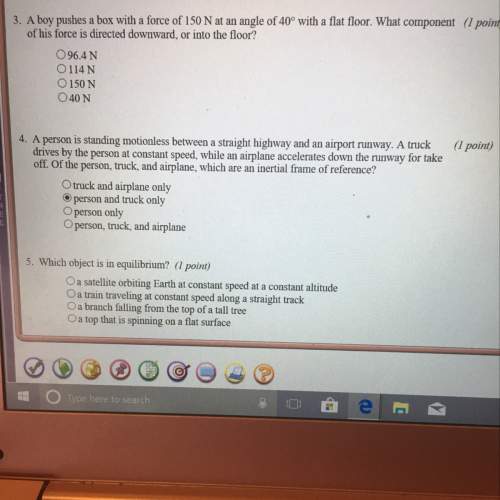
Physics, 13.07.2019 01:20 roberth0518
Consider a dram cell that uses an internal capacitor of 20 ff; it is charged to 3.3 v when storing a 'l'. in this problem, ignore body effect. (a real transistor like the access transistor here, or pass transistors in switch logic, can turn off before you want it to because of body (6-points) effect; this one stays on until the 20 ff capacitor is fully charged.) (a) when writing a t, how long does it take for the voltage on the capacitor to rise to 95% of its final value? assume that when it is on, the access transistor in the cell has an average resistance of 6 kq; assume that the inverter driving the bit line has an average pull-up resistance of 1 k2. ignore the resistance and capacitance of the bit line itself. (in a real memory, wire parasitics play a big (b) suppose that when reading, the bit line is first charged to 3.3 v. the bit line is a large piece of metal, and has a total capacitance of 500 ff. how far does the bit line drop in voltage if a '0' is read? (hint: in circuits, you learned that charge on capacitors in parallel redistributes until the voltage is equal; assume enough time is given for the bit line to drop as far as it ever (c) suppose that the leakage current from the cell, due to the reverse-biased diode and subthreshold mosfet currents, is no more than 2 pa. if a signal loss on the capacitor of 0.5 v can be tolerated, how often must the dram cell be refreshed to ensure that no data is lost?

Answers: 2


Another question on Physics

Physics, 21.06.2019 22:30
Aforce of 200 n is applied to an input piston of cross-sectional area 2 sq. cm pushing it downward 2.8 cm. how far does the output piston of cross-sectional area 12 sq. cm move upward? show all work.
Answers: 1

Physics, 22.06.2019 13:00
The substances that are necessary for producing of certain hormones and that store and transport vitamins
Answers: 1

Physics, 22.06.2019 18:00
Cells in the nervous system have a potential difference of 70 mv across the cell membrane separating the interior of the cell from the extracellular fluid. this potential difference is maintained by ion pumps that move charged ions across the membrane. is this an emf? select the correct answer and explanation. 1)no. the ion pumps cannot separate charges; thus, they cannot create a potential difference. 2)yes. the ion pumps cannot separate charges, but they still can create a potential difference. 3)yes. the ion pumps can actively separate charge; thus, they can create a potential difference. 4)no. the ion pumps can separate charges, but they cannot create a potential difference.
Answers: 1

Physics, 22.06.2019 18:30
Abaseball is thrown from the outfield toward the catcher. when the ball reaches its highest point, which statement is true? (a)its velocity is not zero, but its acceleration is zero. (b) its velocity and its acceleration are both zero. (c) its velocity is perpendicular to its acceleration. (d) its acceleration depends on the angle at which the ball was thrown. (e) none of the above statements are true.
Answers: 1
You know the right answer?
Consider a dram cell that uses an internal capacitor of 20 ff; it is charged to 3.3 v when storing...
Questions

Social Studies, 24.07.2020 23:01


Mathematics, 24.07.2020 23:01


Computers and Technology, 24.07.2020 23:01




English, 24.07.2020 23:01


Mathematics, 24.07.2020 23:01

English, 24.07.2020 23:01

Advanced Placement (AP), 24.07.2020 23:01


Mathematics, 24.07.2020 23:01

Mathematics, 24.07.2020 23:01

Mathematics, 24.07.2020 23:01







